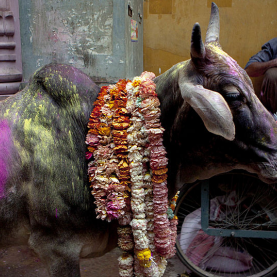Zebu
Zebu cattle come from tropical countries, but are also keen on scorching hot summers. Valued for their milk and meat, they are intensively farmed in Latin America, Central America and Australia. In India, the zebu is crossed with western species to improve its milk yield, resulting in the reduction and even the disappearance of one of its features: its dorsal hump.
The zebu’s journey from India to Switzerland, via Madagascar
The zebu is a humped ox. It has descended from the ancestor of current breeds of cattle domesticated 10 000 years ago throughout the Indian peninsula. It was then introduced to Africa, Australia, Central America and Latin America where, through a series of selections, it hasnow become part of a booming, intensive farming industry.
In India, Hindus regard the zebu as a sacred animal and farmers consider it an excellent worker. It is especially valued for its milk and by-products.
As Madagascar’s emblem and once a symbol of royalty, the zebu is part of every stage of Malagasy life. Throughout life, from birth to death, the redistribution, consumption, gift-giving and offerings of zebu meat and products are all actions which serve as a link between the living and their ancestors, between the natural and the supernatural.
The zebu is also a prestigious animal for the Fulani and the Maasai, two African ethnic groups. The size of the herd shows a family’s status.
To address global warming, Swiss breeders plan to increase the number of zebu cattle in their livestock. This animal produces good quality meat, it is resistant to a large number of diseases, its milk yield does not diminish in high temperatures and it can calve even in hot weather.
Cattle which love the heat
The zebu (Bos taurus indicus L.) is a domesticated bovine adapted to tropical countries. It is a calm, docile animal which requires little care. It is valued for its milk, meat, leather and horns. Its coat is usually light in colour and it has a thick, ample hide which enables it to withstand the heat. It has a dewlap to keep flies at bay and a fatty dorsal hump, which may be small or large, upright or drooping. Its curved horns, longer than those of the ox, may be black or white depending on the variety and are used in the Malagasy craft industry. A zebu’s lifespan is approximately twenty years. It belongs to the only species which can be interbred with other cattle to create new breeds.
Every part of the zebu is valuable
Zebu is the most commonly eaten meat in Madagascar. Almost every part of the animal can be eaten. Kebabs or strips of dried meat, in particular, are sold in the streets. The zebu’s hump is reportedly the best piece of meat in the world, with a similar taste to caviar or truffles.
Zebu milk is deliciously creamy and has been consumed for over 7000 years, mainly transformed into dairy products to be preserved. Kenyans use it to make ash liquid yoghurt and the Madagascans make cheese from it. Indians turn the milk into ghee, a type of clarified butter.
Several nomadic and pastoral tribes use fresh zebu blood as an offering or a fortifying drink.
The hides are used for making drums, the leather for rings and sandals, and shin fragments are made into hair clips and combs. The powdered bone is said to have much goodness while zebu dung is used as a fertiliser, a building material and a disinfectant.
Zebu fat has been used as a raw material for anything from candles to rust-proofing products and hair shine.
Nutrition
Zebu milk has a higher fat and carbohydrate content than other types of milk.
Zebu stealing in Madagascar: a ‘national sport’
In Madagascar, the national sport is Savika, a kind of bullfighting with a zebu. ‘Zebu stealing’ is also practised, as it was in the past. Here the robber gauges his virility according to the number of zebus he steals.
KIPLE, F. Kenneth et ORNELAS, Kriemhild Conneè, 2000. Zebu. In : The Cambridge History of FOOD. Volume 1. pp. 490, 594, 494. Cambridge: Press Syndicate of the University of Cambridge. ISBN: 052140214X





